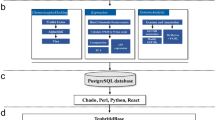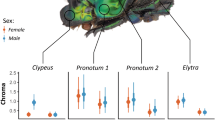Abstract
The oriental fruit fly, Bactrocera dorsalis (Hendel), is a major polyphagous insect pest with a worldwide distribution. The effects of temperature on stage-specific development in B. dorsalis were investigated at eight constant temperatures (13.0 °C, 14.4 °C, 16.2 °C, 19.5 °C, 23.8 °C, 27.7 °C, 31.8 °C and 34.8 °C). B. dorsalis developed successfully from the egg stage to the adult stage at all the tested temperatures, except at the lowest temperatures (13.0 °C and 14.4 °C). Stage-specific lower developmental thresholds and thermal constants were determined using linear regression. The lower and higher temperature threshold (TL and TH, respectively) were estimated using the Sharpe-Schoolfield-Ikemoto model. The lower developmental threshold and thermal constant from egg to adult emergence were 9.8 °C and 325.5 degree-days, respectively. The intrinsic optimum temperatures of the egg, larval, pupal and egg to pupal stage were 20.7 °C, 21.8 °C, 21.1 °C, and 22.4 °C, respectively. The temperature range of the B. dorsalis total immature stage from TL to TH was 20.4 °C (13.8 °C - 34.2 °C). The stage-specific developmental completion of B. dorsalis was determined using a two-parameter Weibull function. The daily adult emergence frequency of B. dorsalis was estimated in relation to adult age and temperature using non-linear developmental rate functions and the Weibull function. The date of cumulative 50% adult emergence estimated using non-linear functions was approximately one day earlier than the experimentally observed date. Thermal performance was compared among B. dorsalis populations from different locations.





Similar content being viewed by others
References
Ahn, J. J., Son, Y., He, Y., Lee, E., & Park, Y.-L. (2016). Effects of temperature on development and voltinism of Chaetodactylus krombeini (Acari: Chaetodactylidae): Implications for climate change impacts. PLoS One, 11(8), e0161319.
Campbell, A., Frazer, B. D., Gilbert, N., Gutierrez, A. P., & Mackauer, M. (1974). Temperature requirements of some aphids and their parasites. Journal of Applied Ecology, 11(2), 431–438.
Chen, L.-G., Zhu, C.-G., & Xia, X.-N. (2010). A preliminary study on the biological characters of Bactrocera dorsalis (Hendel) in Shanghai area. Acta Agriculturae Shanghai, 26(1), 99–101 (Chinese with English abstract).
Chen, S., Fleischer, S., Tobin, P. C., & Saunders, M. C. (2011). Projecting insect voltinism under high and low greenhouse gas emission conditions. Environmental Entomology, 40(3), 505–515.
Christenson, L. D., & Foote, R. H. (1960). Biology of fruit flies. Annual Review of Entomology, 5, 171–192.
Clarke, A. R., Armstrong, K. F., Carmichael, A. E., Milne, J. R., Raghu, S., Roderick, G. K., & Yeates, D. K. (2005). Invasive phytophagous pests arising through a recent tropical evolutionary radiation: The Bactrocera dorsalis complex of fruit flies. Annual Review of Entomology, 50, 293–319.
Curry, G. L., & Feldman, R. M. (1987). Mathematical foundation of population dynamics. The Texas A&M University Press.
de Villiers, M., Hattingh, V., Kriticos, D. J., Brunel, S., Vayssieres, J.-F., Sinzogan, A., Billah, M. K., Mohamed, S. A., Mwatawala, M., Abdelgader, H., Salah, F. E. E., & De Meyer, M. (2016). The potential distribution of Bactrocera dorsalis considering phenology and irrigation patterns. Bulletin of Entomological Research, 106(1), 19–33.
Dixon, A. F. G., Honĕk, A., Kell, P., Kotela, M. A. A., Šizling, A. L., & Jarošik, V. (2009). Relationship between the minimum and maximum temperature thresholds for development in insects. Functional Ecology, 23(2), 257–264.
Drew, R. A., & Hancock, D. L. (1994). The Bactrocera dorsalis complex of fruit flies (Diptera: Tephritidae: Dacinae) in Asia. Bulletin of Entomological Research Supplement Series, 2, 1–68.
Duyck, P.-F., David, P., & Quilici, S. (2004). A review of relationships between interspecific competition and invasions in fruit flies (Diptera: Tephritidae). Ecological Entomology, 29(5), 511–520.
Han, P., Wang, X., Niu, C.-Y., Dong, Y.-C., Zhu, J.-Q., & Desneux, N. (2011). Population dynamics, phenology, and overwintering of Bactrocera dorsalis (Diptera: Tephritidae) in Hubei Province, China. Journal of Pest Science, 84(3), 289–295.
Hardy, D. E. (1973). The fruit flies (Tephritidae-Diptera) of Thailand and bordering countries. Pacific Insects Monograph, 31, 1–353.
Hassani, I. M., Raveloson-Ravaomanarivo, L. H., Delatte, H., Chiroleu, F., Alliberti, A., Noutour, S., Quilici, S., & Duyck, P. F. (2016). Invasion by Bactrocera dorsalis and niche partitioning among tephritid species in Comoros. Bulletin of Entomological Research, 106(6), 749–758.
Hendel, F. (1912). H. Sauter’s Formosa-Ausbeute. Genus Dacus (Dipt.). Supplementa Entomologica, 1, 13–24.
Hong, S. C., Magarey, R. D., Borcher, D. M., Vargas, R. I., & Souder, S. K. (2015). Site-specific temporal and spatial validation of a generic plant pest forecast system with observations of Bactrocera dorsalis (oriental fruit fly). NeoBiota, 27, 37–67.
Huang, Y.-B., & Chi, H. (2014). Fitness of Bactrocear dorsalis (Hendel) on seven host plants and an artificial diet. Turkish Journal of Entomology, 38(4), 401–414.
Ikemoto, T. (2005). Intrinsic optimum temperature for development of insects and mites. Environmental Entomology, 34(6), 1377–1387.
Ikemoto, T., Kurahashi, I., & Shi, P.-J. (2013). Confidence interval of intrinsic optimum temperature estimated using thermodynamics SSI model. Insect Science, 20(3), 420–428.
Jandel Scientific. (1994). TableCurve User’s manual San Rafael, CA.
Jiang, X.-L., He, W.-Z., Xiao, S., Ren, L.-Q., Sun, B.-Z., & Zhang, C.-H. (2001). Study on the biology and survival of Bactrocera dorsalis in the border region of Yunnan. Journal of Southwest Agricultural University., 23, 510–517 (Chinese with English abstract).
Jose, M. S., Leblanc, L., Geib, S. M., & Rubinoff, D. (2013). An evaluation of the species status of Bactrocera invadens and the systematics of the Bactrocera dorsalis (Diptera: Tephritidae) complex. Annals of the Entomological Society of America, 106(6), 684–694.
Kean, J. M. (2015). Meta-analysis, validation and application of fruit fly development times. New Zealand Plant Protection, 68, 44–53.
Kriticos, D. J., Stephens, A. E. A., & Leriche, A. (2007). Effect of climate change on oriental fruit fly in New Zealand and the Pacific. New Zealand Plant Protection, 60, 271–278.
Leblanc, L., Vueti, E. T., & Allwood, A. J. (2013). Host Plant Records for Fruit Flies (Diptera: Tephritidae: Dacini) in the Pacific Islands: 2. Infestation statistics on economic hosts. Proceedings of the Hawaiian Entomological Society, 45, 83–117.
Leblanc, L., Jose, M. S., Barr, N., & Rubinoff, D. (2015). A phylogenetic assessment of the polyphyletic nature and intraspecific color polymorphism in the Bactrocera dorsalis complex (Diptera, Tephritidae). ZooKeys, 540, 339–367.
Luo, Z.-X., Ren, L.-L., Qi, L.-Y., Zhou, S.-D., & Dai, H.-G. (2009). Effects of temperature on the development of Bactrocera dorsalis (Diptera: Tephritidae) population. Chinese Journal of Ecology, 28, 921–924 (Chinese with English abstract).
Magarey, R. D., Borchert, D. M., Fowler, G. A., & Hong, S. C. (2015). The NCSU/APHIS plant pest forecasting system (NAPPFAST). In R. C. Venette (Ed.), Pest risk modeling and mapping for invasive alien species (pp. 82–96). Oxfordshire: CABI.
Martin-Vertedor, D., Ferrero-Garcia, J. J., & Torres-Vila, L. M. (2010). Global warming affects phenology and voltinism of Lobesia botrana in Spain. Agricultural and Forest Entomology, 12(2), 169–176.
R Core Team. (2015). R: A language and environment for statistical computing. Vienna: R Foundation for Statistical Computing.
SAS Institute. (1999). SAS user’s guide; statistics version 9.1ed. Cary, NC: SAS Institute.
Schoolfield, R. M., Sharpe, P. J. H., & Magnuson, C. E. (1981). Non-linear regression of biological temperature-dependent rate models based on absolute reaction-rate theory. Journal of Theoretical Biology, 88(4), 719–731.
Schutze, M. K., Aketarawong, N., Amornsak, W., Armstrong, K. F., & Augustinos, A. A. (2015). Synonymization of key pest species within the Bactrocera dorsalis species complex (Diptera: Tephritidae): Taxonomic changes based on a review of 20 years of integrative morphological, molecular, cytogenetic, behavioural and chemoecological data. Systematic Entomology, 40(2), 456–471.
Sharpe, P. J. H., & DeMichele, D. W. (1977). Reaction kinetics of poikilotherm development. Journal of Theoretical Biology, 64(4), 649–670.
Shi, P., Ge, F., Sun, Y., & Chen, C. (2011a). A simple model for describing the effect of temperature on insect developmental rate. Journal of Asia-Pacific Entomology, 14(1), 15–20.
Shi, P., Ikemoto, T., Egami, C., Sun, Y., & Ge, F. (2011b). A modified program for estimating the parameters of the SSI model. Environmental Entomology, 40(2), 462–469.
Sridhar, V., Verghese, A., Vinesh, L. S., Jayashankar, M., & Kamala Jayanth, P. D. (2014). CLIMEX simulated predictions of oriental fruit fly, Bactrocera dorsalis (Hendel) (Diptera: Tephritidae) geographical distribution under climate change situations in India. Current Science, 106(12), 1702–1710.
Stephens, A. E. A., Kriticos, D. J., & Leriche, A. (2007). The current and future potential geographical distribution of the oriental fruit fly, Bactrocera dorsalis (Diptera: Tephritidae). Bulletin of Entomological Research, 97(4), 369–378.
van der Have, T. M. (2002). A proximate model for thermal tolerance in ectotherms. Oikos, 98(1), 141–155.
Vargas, R. I., Walsh, W. A., Jang, E. B., Armstrong, J. W., & Kanehisa, D. T. (1996). Survival and development of immature stages of four Hawaiian fruit flies (Diptera: Tephritidae) reared at five constant temperatures. Annals of the Entomological Society of America, 89(1), 64–69.
Wagner, T. L., Wu, H. I., Sharpe, P. J. H., Schoolfield, R. M., & Coulson, B. N. (1984). Modeling insect development rates: A literature review and application of a biophysical model. Annals of the Entomological Society of America, 77(2), 208–225.
Wan, X., Liu, Y., & Zhang, B. (2012). Invasion history of the oriental fruit fly, Bactrocera dorsalis, in the Pacific-Asia region: Two main invasion routes. PLoS One, 7(5), e36176.
Wang, N., Li, Z., Wu, J., Rajotte, E. G., Wan, F., & Wang, Z. (2009). The potential geographical distribution of Bactrocera dorsalis (Diptera: Tephrididae) in China based on emergence rate model and ArcGIS. In: Li, D., Chunjiang, Z. (Eds.) IFIP International Federation for Information Processing Vol 239 Computer and computing technologies in agriculture II Vol I, Spring, Boston, (pp. 399–411).
Weibull, W. (1951). A statistical distribution functions with wide applicability. Journal of Applied Mechanics, 18, 293–297.
Wu, J., Liang, F., & Liang, G. (2000). Study on the relation between developmental rate of oriental fruit fly and its ambient temperature. Plant Quarantine, 14, 321–324 (Chinese with English abstract).
Yang, P., Carey, J. R., & Dowell, R. V. (1994). Temperature influence on the development and demography of Bactrocear dorsalis (Diptera: Tephritidae) in China. Environmental Entomology, 23(4), 971–974.
Yuan, S.-Y., Kong, Q., Xiao, C., Chen, B., Li, Z.-Y., & Gao, Y.-H. (2005). Developmental threshold temperature and effective cumulative temperature of Bactrocera dorsalis Hendel. Journal of Southwest Agricultural University, 27(3), 316–318 (Chinese with English abstract).
Zhan, K.-R., Zhao, S.-X., Zhu, S.-F., Zhou, W.-C., & Wang, N.-W. (2006). Study on viability of Bactrocera dorsalis in China. Journal of South China Agricultural University, 27(1), 21–25 (Chinese with English abstract).
Zheng, S. (2013). Population dynamics and density of Bactrocera dorsalis (Hendel) in different habitats. Acta Ecologica Sinica, 33(24), 7699–7706 (Chinese with English abstract).
Acknowledgements
This study was conducted under an international cooperative research project (Project Title: Development of population model of foreign fruit fly and prediction of their settlement to cope with climate change, No: PJ012075) between National Chung Hsing University, Taiwan and National Institute of Horticultural and Herbal Science, Rural Development Administration, Republic of Korea. We appreciate Dr. Manoukis and one anonymous reviewer for valuable comments on the manuscripts. The authors thank Dr. Yuan Shen for providing meteorological data. The authors are extremely grateful to Dr. Peijian Shi for providing the SSI program. Funding for this research was provided by the Rural Development Administration, Republic of Korea.
Author information
Authors and Affiliations
Corresponding author
Ethics declarations
Conflict of interest
The authors declare that they have no conflict of interest.
Rights and permissions
About this article
Cite this article
Samayoa, A.C., Choi, K.S., Wang, YS. et al. Thermal effects on the development of Bactrocera dorsalis (Hendel) (Diptera: Tephritidae) and model validation in Taiwan. Phytoparasitica 46, 365–376 (2018). https://doi.org/10.1007/s12600-018-0674-6
Received:
Accepted:
Published:
Issue Date:
DOI: https://doi.org/10.1007/s12600-018-0674-6




